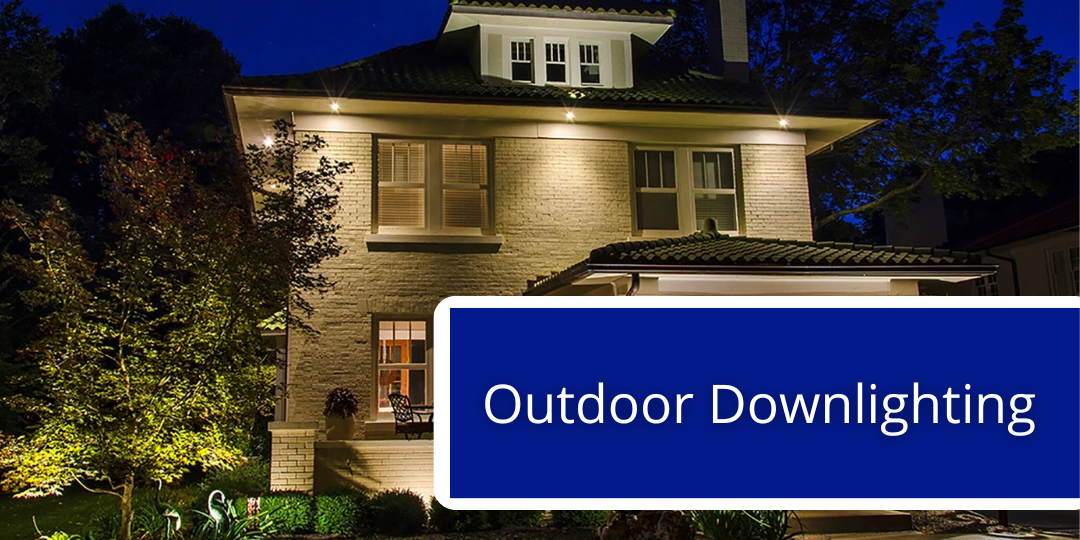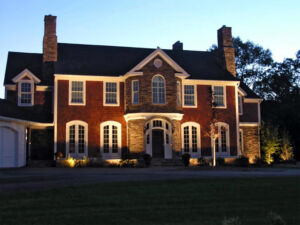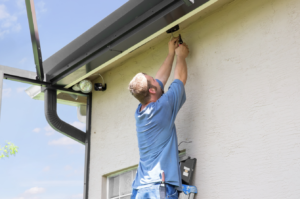
Downlighting has become one of the most popular trends in outdoor lighting, utilizing fixtures to cleverly mimic the effects of nature, such as moonlight. It is also often referred to as moonlighting. This is where you create a softly lit ambience by installing downlights that allow beams and shadows to lightly scatter across surfaces. This motif creates a beautiful reflection that replicates the look of moonlight, creating an inviting atmosphere.
What Is Downlighting?
Downlighting is a type of lighting system that directs light downward onto surfaces. This particular type of lighting is generally used to cast a wide beam and illuminate an entire area, rather than focus on one particular spot or feature. Downlighting is meant to feel natural, like the moon and stars providing gentle radiance over a landscaped area. This encourages a sense of warmth, comfort, and security as people are walking around at night.
Outdoor downlighting can also be used to create architectural effects such as lightly cast shadows trickling along the walls or in wide archways. It’s becoming increasingly popular with landscape architects for its ability to provide an ideal illumination without having harsh lights pointing directly downwards. This helps reduce glare and provides soothing illumination for surfaces. When done right, outdoor downlighting lends an elegant touch to any home or landscape while also keeping energy costs low.
How To Position Downlights
Positioning downlights correctly is an essential part of your outdoor lighting scheme. It’s important to accurately plan out where downlights should be placed, as this affects how much illumination is achieved. Downlights should be installed above areas where accent lighting is needed.
As the light needs to shine downwards, in order to achieve a natural effect, it is best to mount high up; this could include within the branches of trees or mounted beneath eaves on your home. Placing the light sources at differing heights or distances will help to create a sense of depth in the outdoor area. If a wide beam angle is needed, it may be necessary to install multiple luminaires rather than one single source, as this helps to evenly spread the light around more effectively.
To avoid glare and hotspots, select carefully aimed fittings and consider including shielding on the lights themselves. This all ensures that when positioned properly outdoors, downlighting creates an inviting atmosphere with unobtrusive lighting that doesn’t overpower its surroundings.
Downlighting Fixtures
The fixtures you choose for downlighting are just as important as the placement of the lights. The wrong type of fixture can produce an unnatural effect and disrupt the ambiance. It is best to use fixtures that are designed for moonlighting or mounting in trees, as the design of these fixtures are specifically suited to this purpose.
Installing Downlighting
When looking to install outdoor downlighting, it is important to consider the expertise of a professional outdoor lighting company. Professional installers have the experience and know-how needed to correctly plan, design, and install an effective downlighting system tailored to your specific needs.They can provide valuable insight into the best placement for the fixtures, as well as determine if any additional features need to be installed such as dimmers, motion sensors, or timers.
If you’re located in D.C., Maryland, or Virginia and are looking for an experienced, trustworthy team to help you with your outdoor downlighting project, look no further than Landscape Lighting Designers Plus. Our team offers exceptional customer service and will work with you to create the exact look and design that you desire. Our experienced technicians use the latest in lighting technology as well as high-grade materials to ensure your project looks great and lasts for years to come. Contact us today at 888-582-8845.



